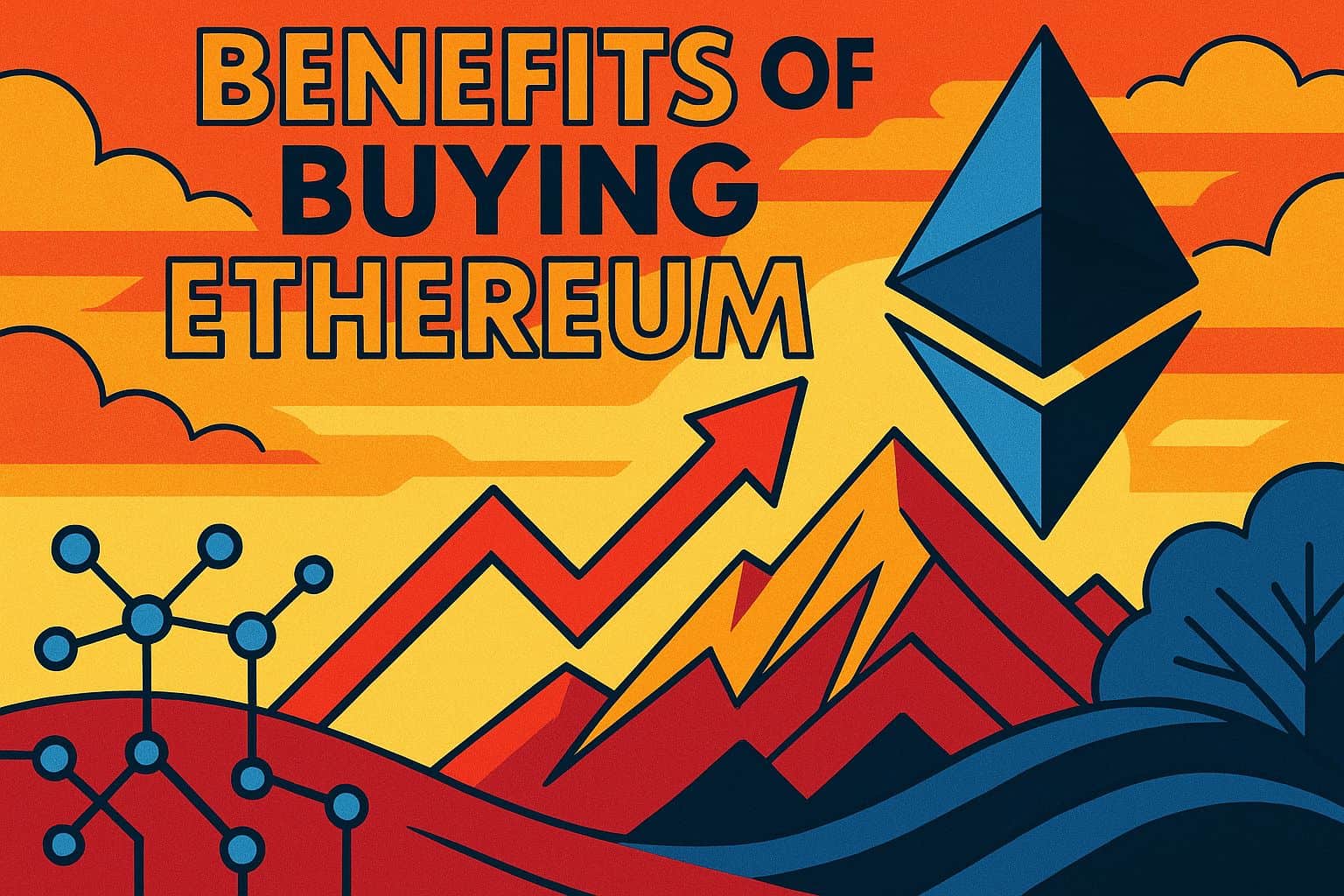Many crypto investors struggle to understand why Ethereum stands out in a crowded digital currency market. Ethereum launched in July 2015 as the largest decentralized software platform, designed specifically for smart contracts and decentralized applications.
This guide breaks down the key benefits of buying Ethereum, from its advanced blockchain technology to its real-world applications in decentralized finance and digital assets. Get ready to discover why Ethereum could be your next smart investment move.
Key Takeaways
Ethereum’s smart contracts and Proof of Stake system create unique investment opportunities beyond simple digital currency transactions.
ETH delivered 65% gains in 30 days and analysts project prices could reach $6,400-$13,000 by 2025-2026.
Ethereum’s transition to Proof of Stake cut energy consumption by 99.95% while improving transaction speeds significantly.
DeFi applications on Ethereum enable lending, borrowing, and trading without traditional banks or financial intermediaries.
Ethereum powers the largest developer ecosystem in crypto, with over 4,000 active contributors building Web3 applications.
Table of Contents
Key Features That Make Ethereum Unique

Ethereum stands apart from other cryptocurrencies through three core features that make it a powerhouse in the blockchain space. Smart contracts, decentralized applications, and its shift to Proof of Stake create a unique ecosystem that goes far beyond simple digital currency transactions.
What is smart contract functionality and why does it matter?

Smart contracts are self-executing programs that run on the Ethereum blockchain, automatically carrying out agreements once specific conditions are met. These digital contracts reduce the need for intermediaries like banks or lawyers, making transactions faster and cheaper.
The code of Ethereum smart contracts is publicly visible, which increases transparency and allows anyone to verify what the contract does. Once deployed, smart contracts become immutable, meaning their code cannot be altered, which enhances security for all parties involved.
I’ve personally used smart contracts for DeFi lending, and the experience was efficient… no paperwork, no waiting for approval, just instant execution once my collateral was deposited.
Smart contracts automate transactions based on predefined conditions, increasing efficiency and reducing the need for intermediaries.
Smart contract functionality is important because it creates a system where parties don’t need to know or trust each other to conduct business. The Ethereum Virtual Machine executes these contracts on the blockchain, ensuring decentralization and transparency across all transactions.
This technology powers everything from decentralized finance (DeFi) platforms to non-fungible tokens (NFTs), creating new investment opportunities and passive income streams. Ethereum’s open-source nature allows developers worldwide to collaborate and improve, constantly expanding what’s possible with smart contracts.
You can track Ethereum’s performance and smart contract activity on platforms like Binance, where real-time data shows the growing adoption of this technology.
How does the decentralized application (dApp) ecosystem work?

Smart contracts provide the foundation, but decentralized applications (dApps) build entire ecosystems on top of this technology. The dApp ecosystem uses a two-layer structure that makes everything work smoothly.
The execution layer handles all transactions and validation processes. The consensus layer manages how the network agrees on changes and updates.
Decentralized applications on Ethereum operate on a blockchain or P2P network, not a single computer. This setup means no single company or person controls the app. Users interact directly with the blockchain through their cryptocurrency wallets.
The Dencun upgrade introduced proto-danksharding, improving scalability and performance for dApps. Gas fees power these applications, paying for the computing power needed to run transactions.
Developers can build anything from decentralized exchanges like Uniswap to complex financial tools. Each dApp connects to Ethereum’s network, creating a vast ecosystem where digital assets flow freely between different applications.
What benefits come with Ethereum’s transition to Proof of Stake (Ethereum 2.0)?

Ethereum’s move to proof of stake (PoS) in September 2022 brought massive environmental benefits, cutting energy consumption by 99.95%. Validators now stake ether (ETH) instead of mining cryptocurrency, which eliminates the need for energy-hungry mining pools.
This shift makes Ethereum far more sustainable than proof of work (PoW) systems. Average block times dropped to around 12 seconds, boosting transaction speed significantly. The network can process about 14 transactions per second currently, with future upgrades potentially reaching 100,000 TPS.
Staking offers new ways to earn passive income from your digital assets. Solo staking requires a minimum of 32 ETH, though many investors use staking pools for smaller amounts. The LMD Ghost consensus algorithm improves block selection efficiency while strengthening network security.
Gas fees become more predictable under this system, making decentralized applications (dapps) more cost-effective to use. These improvements position Ethereum as a stronger foundation for decentralized finance (DeFi) applications and the broader cryptocurrency market.
Now let’s examine the financial benefits that make buying Ethereum attractive to investors.
What Are the Financial Benefits of Buying Ethereum?

Ethereum offers compelling financial opportunities that extend far beyond simple price appreciation. Smart investors discover multiple revenue streams through staking rewards, DeFi protocols, and capital gains potential in the expanding cryptocurrency market.
Can buying Ethereum lead to high returns?

Ethereum has delivered impressive capital gains for early investors. ETH surged 65% over 30 days, crushing Bitcoin’s 15% increase during the same period. The digital currency peaked at approximately $4,800 in November 2021, though it later dropped to around $1,000 within seven months.
This volatility shows both the potential rewards and risks of cryptocurrency investments.
Market analysts project ETH prices could reach $6,400 to $13,000 by 2025-2026. Ethereum’s market capitalization hit roughly $450 billion, making it the second-largest digital asset after Bitcoin.
Smart contracts and decentralized applications drive much of this growth, creating real utility beyond simple speculation. The stablecoin market built on Ethereum expanded from $20 billion in 2020 to $250 billion in 2024, with predictions pointing toward $2 trillion in the future.
How liquid is Ethereum in the market?

Ethereum is the most liquid asset in the cryptocurrency market, making it very easy to buy and sell at any time. Its massive market capitalization and high demand from investors create a trading environment where you can execute transactions quickly without major price impacts.
Major centralized exchanges like Coinbase, Binance, and Kraken offer deep order books for ether (ETH), ensuring tight bid-ask spreads that benefit both day traders and long-term holders.
The platform’s support for decentralized finance (DeFi) protocols and non-fungible tokens (NFTs) drives constant trading activity, further boosting its liquidity profile across multiple blockchain networks.
Smart contracts and decentralized applications (dApps) built on Ethereum create additional layers of liquidity through automated market makers and liquidity pools. These DeFi protocols allow users to provide liquidity and earn rewards, creating a self-sustaining ecosystem that keeps ether flowing through various digital assets and trading pairs.
The development of decentralized applications continues to attract institutional investors and retail traders alike, maintaining Ethereum’s position as a highly liquid investment option.
This liquidity advantage enables various investment strategies, from simple buy and hold approaches to more complex margin trading and leverage trading techniques that experienced crypto traders use to maximize their returns.
“Liquidity is the lifeblood of any financial market, and Ethereum has proven itself as the most liquid cryptocurrency after Bitcoin, with daily trading volumes consistently exceeding billions of dollars across global exchanges.”
Is Ethereum a good hedge against inflation?

Ethereum offers strong protection against inflation because it operates outside traditional financial systems. Unlike the U.S. dollar, which central banks can print endlessly, Ethereum has built-in scarcity mechanisms.
The proof of stake (PoS) system actually burns some ether (ETH) tokens during transactions, creating deflationary pressure. This makes digital assets like Ethereum attractive alternatives to bonds or t-bills that lose value during inflationary periods.
Many crypto industry experts view Ethereum alongside Bitcoin as a hedge against dollar devaluation. The cryptocurrency market has shown resilience during times of rising prices and economic uncertainty.
Smart contracts and decentralized finance (DeFi) applications give Ethereum real utility beyond just being a store of value. This practical use case strengthens its position as an alternative asset class that can protect wealth from inflation’s erosive effects.
What Technological Advantages Does Ethereum Offer?

Ethereum’s blockchain technology offers several key tech advantages that make it stand out from other digital currencies… and these features could change how you think about cryptocurrency investments.
What makes Ethereum’s blockchain infrastructure advanced?

Ethereum’s blockchain infrastructure is notable for its Turing-complete code capabilities, allowing developers to create complex programs and smart contracts beyond simple transactions.
The Ethereum Virtual Machine (EVM) executes these smart contracts, using Ether as the transaction currency for network operations. This system processes transactions in seconds, offering faster confirmation times compared to Bitcoin’s longer delays.
The platform’s average block time of about 12 seconds enables quick transaction confirmations, making it suitable for real-time applications and high-frequency trading scenarios.
Smart contracts on Ethereum operate through decentralized protocols that improve security against fraud while reducing operational costs for businesses and developers. The blockchain supports digital token creation and decentralized autonomous organizations (DAOs), giving stakeholders direct governance control over their projects and investments.
Gas fees provide a flexible pricing mechanism that adjusts based on network demand, ensuring efficient resource allocation across the ecosystem. These technical features combine to create a foundation for decentralized applications (dapps) and decentralized finance (defi) protocols that support today’s digital economy.
The Ethereum Virtual Machine is a world computer that continuously runs, executing smart contracts with mathematical precision and reliability.
These infrastructure advantages result in significant performance improvements that benefit both developers and end users across the platform.
How do scalability and performance upgrades improve Ethereum?

Scalability upgrades transform Ethereum into a powerhouse that can handle millions of users without breaking a sweat. Sharding splits the blockchain into smaller pieces, letting the network process more transactions at once.
Layer 2 scaling solutions like Optimism and Arbitrum work on top of the main blockchain technology to slash gas fees and reduce network congestion.
These improvements mean you spend less on transaction fees while enjoying faster transaction speed across decentralized applications (dapps) and smart contracts.
Performance upgrades like Proto-Danksharding push Ethereum’s capabilities even further. The Surge update brings massive improvements to how the network handles data and processes transactions.
Developers building on ethereum blockchains benefit from lower operational costs, making it cheaper to create and run decentralized finance (defi) platforms and non-fungible tokens (nfts).
Users get a smoother experience with their digital assets, while the entire cryptocurrency market gains from a more efficient blockchain that can compete with traditional payment systems.
Why is Ethereum flexible for developers?

Beyond performance improvements, Ethereum’s true strength lies in its developer-friendly architecture. The platform supports multiple programming languages, making it accessible to coders from different backgrounds.
Developers can create custom tokens, NFTs, and complex smart contract systems on Ethereum without learning entirely new frameworks. This flexibility stems from Ethereum’s modular design, which allows programmers to build applications piece by piece.
An extensive developer community provides resources, tools, and security audits that speed up the development process. Ethereum’s open-source nature allows for community contributions and code reviews, creating a collaborative environment where bugs get fixed quickly.
Interoperability enables integration with other blockchains and systems for broader applications, giving developers more options for their projects. The Ethereum Foundation actively supports this ecosystem by funding development tools and educational resources that make blockchain technology more approachable for newcomers.
How Is Ethereum Used in the Real World?

Ethereum powers real-world applications that go far beyond simple digital currency trading. From DeFi platforms that let you earn yield on your crypto holdings to NFT marketplaces where artists sell unique digital assets, Ethereum’s smart contracts make these complex financial operations possible without traditional banks or intermediaries.
What are Decentralized Finance (DeFi) applications?
DeFi applications represent a complete change from traditional banking systems, operating entirely on blockchain technology without central authorities. These protocols include Compound for lending, Bancor for automated market making, and MakerDAO for decentralized stablecoins.
Smart contracts handle all transactions automatically, eliminating the need for banks or financial intermediaries. Users can lend, borrow, trade, and earn interest directly through these platforms.
Gas fees on the Ethereum network power these transactions, though they fluctuate based on network congestion.
Major DeFi protocols cover derivatives trading, decentralized exchanges (DEXs), lending platforms, asset management tools, and stablecoins. Transaction volume across these platforms shows rapid growth, with projections indicating DeFi will exceed $100 billion in volume within five years.
The ecosystem reduces transaction fees significantly compared to traditional finance while increasing accessibility for users worldwide. Digital assets flow freely through these protocols, creating new opportunities for passive income through yield farming and liquidity provision.
DeFi uses Ethereum’s blockchain for increased security and transparency, significantly changing how we think about financial services.
How do Non-Fungible Tokens (NFTs) rely on Ethereum?
Non-fungible tokens (NFTs) depend on Ethereum’s blockchain technology for their core functions. Smart contracts handle the creation and management of these unique digital assets, making sure each token stays authentic and proves ownership.
Every NFT contains three key parts: CONTRACTADDRESS, TOKENID, and metadata fields that store important information about the digital item. Ethereum’s network processes all NFT transactions through these smart contracts, which run automatically without human control.
Ethereum’s wide acceptance across the crypto world makes NFT adoption much easier for creators and buyers. The blockchain provides a decentralized and secure environment for NFT transactions, so users don’t need to trust a central authority.
Gas fees on Ethereum pay for the computing power needed to mint, buy, and sell NFTs. This system lets artists, gamers, and collectors trade digital assets with confidence, knowing the blockchain records every transaction permanently.
What does tokenization of assets mean on Ethereum?
Asset tokenization on Ethereum converts traditional assets like real estate, bonds, and carbon credits into digital tokens. This process creates blockchain-based representations of physical or financial assets, making them tradeable on decentralized networks.
Smart contracts handle the technical framework, ensuring each token represents a specific portion of the underlying asset. Blockchain technology provides transparency and reduces fraud risk through its public ledger system.
Tokenization enables fractional ownership, which increases liquidity in traditionally illiquid asset classes. Projects like Securitize, Ondo Finance, and JP Morgan’s Onyx demonstrate real-world applications of this technology.
The process involves creating digital tokens, implementing smart contracts for governance, and enabling secondary market trading. Investors gain confidence through decentralization and transparent blockchain records, while asset owners access broader markets and improved liquidity for their holdings.
Ethereum’s Expanding Ecosystem

Ethereum’s ecosystem grows bigger every day, with thousands of developers building new decentralized applications and smart contracts on the platform. This massive network of creators, businesses, and blockchain technology users makes Ethereum one of the most active spaces in the cryptocurrency market.
How active is the Ethereum developer community?
The Ethereum developer ecosystem shows remarkable growth and activity across multiple fronts. Vitalik Buterin’s platform attracts thousands of developers who build smart contracts, decentralized applications (dapps), and digital assets daily.
GitHub statistics reveal over 4,000 active contributors working on Ethereum’s core protocol, while the broader ecosystem includes tens of thousands of developers creating everything from decentralized finance (DeFi) protocols to non-fungible tokens (NFTs).
Major programming languages like Solidity see constant updates, and developer tools receive regular improvements to support blockchain technology innovation.
Network upgrades like The Verge, The Purge, and The Splurge drive this developer momentum forward. These improvements focus on scalability, reduced gas fees, and better performance for cryptocurrency market participants.
Developer conferences, hackathons, and online forums buzz with activity as programmers explore new use cases for tokenized assets and blockchain technologies. The transition to proof of stake (PoS) from proof of work (PoW) created fresh opportunities for developers to build more efficient applications, attracting talent from traditional tech companies and startups alike.
What is Ethereum’s role in Web3 applications?
Ethereum serves as the foundation for Web3 applications, providing the infrastructure that makes decentralized internet possible. Smart contracts on Ethereum enable programmable money and automated systems that run without central control.
Decentralized applications (dApps) built on this blockchain technology create new ways for users to interact online. These applications give people direct ownership of their digital assets and data, removing the need for traditional intermediaries.
Web3 platforms use Ethereum’s open-source blockchain to build everything from social networks to gaming platforms. Users can participate in governance through token holding, making decisions about how these platforms evolve.
Layer 2 solutions enhance Ethereum’s Web3 functionality by reducing gas fees and improving transaction speed. Interoperability bridges connect Ethereum to other blockchain networks, expanding the possibilities for cross-chain applications.
Developers choose Ethereum because it supports complex smart contract functionality that powers DeFi protocols, NFT marketplaces, and DAOs. Vitalik Buterin’s creation has become the go-to platform for building decentralized systems that prioritize user ownership.
The transition to proof of stake (PoS) makes Ethereum more sustainable while maintaining its role as the primary infrastructure for Web3 innovation. Major enterprises partner with Ethereum-based projects, recognizing its potential to reshape how we interact with digital services and manage online identity.
Which major enterprises have partnered with Ethereum?
Major corporations have made significant moves into the Ethereum ecosystem, proving its real-world value. PayPal launched its U.S. dollar-pegged stablecoin, PYUSD, on Ethereum in August 2023, bringing mainstream payment processing to blockchain technology.
Deutsche Bank collaborates with Matter Labs on Project DAMA 2, an Ethereum rollup designed for global finance operations. Sony developed the Soneium rollup on Ethereum specifically for gaming and finance applications, showing how entertainment giants see potential in decentralized applications.
Fashion and retail brands have also embraced Ethereum’s capabilities for digital assets and smart contracts. Louis Vuitton and Adidas are actively involved with Ethereum-based projects, using the platform for non-fungible tokens and customer engagement.
These partnerships demonstrate how traditional industries are integrating cryptocurrency market solutions into their business models. The growing list of enterprise adoption signals strong investor sentiment and validates Ethereum’s position in the broader cryptocurrency landscape.
How Does Ethereum Compare to Bitcoin?

While Bitcoin operates as digital cash using proof of work, Ethereum functions as a programmable blockchain platform that supports smart contracts, decentralized applications, and runs on the more energy-efficient proof of stake consensus mechanism.
Bitcoin processes around 7 transactions per second, but Ethereum handles roughly 15 transactions per second with plans for massive scalability improvements through layer-2 solutions and sharding upgrades.
The cryptocurrency market sees Bitcoin as digital gold for storing value, while Ethereum serves as the foundation for decentralized finance protocols, non-fungible tokens, and Web3 applications that extend far beyond simple peer-to-peer payments.
Transaction fees on Bitcoin remain relatively stable, but Ethereum’s gas fees fluctuate based on network demand and complexity of operations being executed. Vitalik Buterin designed Ethereum to be a world computer, whereas Satoshi Nakamoto created Bitcoin as an electronic cash system for financial transactions without intermediaries.
Keep reading.
Why are Ethereum’s transaction speeds faster?
Ethereum’s blockchain technology delivers significantly faster transaction speeds compared to Bitcoin’s network. After Ethereum moved to Proof of Stake (PoS) in 2022, the platform achieves block times of 10-15 seconds versus Bitcoin’s 10 minutes to an hour.
This dramatic improvement stems from PoS consensus mechanism requiring less computational power than Bitcoin’s Proof of Work (PoW) system. Lower energy consumption allows validators to process transactions much quicker, creating a more efficient digital currency ecosystem.
Transaction volume data reveals Ethereum’s superior processing capabilities in real-world scenarios. As of August 2023, Ethereum processes about 1 million transactions daily, compared to Bitcoin’s 550,000 transactions for an entire month.
Gas fees on Ethereum let users prioritize their transactions for faster confirmation times by paying higher transaction fees. Smart contracts and decentralized applications (dApps) benefit from this speed advantage, making the cryptocurrency market more responsive for developers building on Ethereum’s infrastructure.
What applications does Ethereum support beyond Bitcoin?
While Bitcoin primarily focuses on rapid transactions, Ethereum enables numerous applications beyond digital currency. Smart contracts enable this expanded functionality, allowing developers to create complex programs that operate automatically on the blockchain without human supervision.
Decentralized applications (dApps) represent one of Ethereum’s key strengths. These apps function like regular software but operate on blockchain technology instead of centralized servers.
I’ve used several DeFi platforms that allow me to lend crypto, trade tokens, and earn interest without traditional banks. Gaming dApps create virtual worlds where players own their digital assets.
Supply chain applications track products from factory to store, providing consumers full transparency about their purchases. Identity verification systems built on Ethereum help people control their personal data instead of giving it to large tech companies.
Developers can create their own tokens for specific projects, build DAOs that allow communities to make decisions together, and design management systems that operate without central authority.
Non-fungible tokens (NFTs) demonstrate another major use case, enabling artists and creators to sell unique digital items directly to buyers. Vitalik Buterin created this platform to support all these applications through its adaptable programming language and strong infrastructure.
How does Ethereum’s Proof of Stake improve sustainability?
Ethereum’s transition to proof of stake (PoS) in September 2022 marked a massive win for environmental sustainability. The network slashed its energy requirements by 99.95%, making it one of the most eco-friendly blockchain platforms available.
This shift replaced energy-hungry miners with validators who stake their ether (ETH) to secure the network. Validators consume far less electricity than traditional Bitcoin mining operations, which still rely on proof of work (PoW) systems.
The PoS mechanism transforms how the Ethereum network processes transactions and maintains security. Validators confirm blocks based on their staked digital assets rather than competing in energy-intensive computational races.
This change eliminates the need for massive server farms that consume enormous amounts of electricity. The improved efficiency also leads to faster transaction confirmations and reduced gas fees, creating a more sustainable cryptocurrency market for developers building decentralized applications (dapps) and smart contracts.
What Risks Should You Consider Before Buying Ethereum?

While Ethereum offers exciting opportunities in the cryptocurrency market, smart investors must understand the potential downsides before diving in. Market volatility can trigger margin calls, regulatory changes threaten digital assets, and fierce competition from other blockchain networks could impact ETH’s future dominance.
How does competition from other blockchains affect Ethereum?
Competition from newer blockchain networks puts serious pressure on Ethereum’s market position. Solana processes up to 2,600 TPS, making Ethereum’s 15-30 TPS look sluggish by comparison.
Cardano, Polygon, BNB Chain, and ICP all offer faster transaction speeds and lower fees than Ethereum’s network. These alternatives attract developers who want cheaper gas fees and quicker transaction processing for their decentralized applications (dapps).
Despite this fierce competition, Ethereum still holds the majority of total value locked (TVL) in DeFi protocols. I’ve noticed that many projects start on faster chains but eventually bridge to Ethereum for its established ecosystem and security.
The cryptocurrency market seems to be moving toward a multi-chain future where different blockchain networks serve specialized roles. This shift means Ethereum might focus on high-value transactions and complex smart contracts, while competitors handle everyday transfers and gaming applications.
Addressing concerns about Ethereum’s future viability becomes crucial as this competitive landscape continues evolving.
What causes volatility in Ethereum’s market price?
Competition affects Ethereum’s price stability, but many other factors create the wild price swings that make this cryptocurrency so unpredictable. Ethereum’s price movements follow patterns that can shock even experienced traders.
The digital currency peaked at around $4,800 in November 2021, then crashed to roughly $1,000 within just seven months. This dramatic fall shows how quickly market sentiment can shift and destroy investor confidence.
Market demand drives most price changes in the cryptocurrency market. News events, regulatory announcements, and overall investor mood create massive buying or selling waves. Technical analysis tools like candlestick charts, Fibonacci levels, and trend indicators help traders track these movements, but they can’t predict the emotional reactions that fuel volatility.
Gas fees on the Ethereum network also impact price action, as high transaction costs can reduce user activity and affect demand for ether (ETH). Smart contracts and decentralized applications (dapps) usage patterns influence how much people want to hold ETH, creating feedback loops that amplify price swings in both directions.
What regulatory uncertainties impact Ethereum?
Regulatory clarity for digital assets remains unclear, creating significant uncertainty for Ethereum investors and developers. Government agencies worldwide struggle to define whether ether (ETH) qualifies as a security, commodity, or digital currency.
This classification directly impacts how cryptocurrency regulations apply to Ethereum trading, staking, and smart contracts development. The Securities and Exchange Commission continues debating rules that could affect centralized exchange listings and investment adviser recommendations for digital assets.
Restrictive regulations and taxation policies pose serious threats to Ethereum’s growth potential. Some governments consider bans on proof of stake (PoS) networks or limitations on decentralized finance (DeFi) applications built on blockchain technology.
Tax authorities haven’t established clear guidelines for gas fees, transaction fees, or staking rewards, leaving investors confused about reporting requirements. These regulatory gaps create risks for anyone holding ether as part of their cryptocurrency market portfolio, especially those following investment advice from financial advisors who lack clear compliance frameworks.
How Can You Invest in Ethereum?

Ethereum offers several paths for investors looking to enter the cryptocurrency market, from simple buy-and-hold strategies to more complex trading approaches. Each method comes with different risk levels and potential rewards, making it crucial to understand your options before diving into digital assets.
What is the buy and hold strategy for Ethereum?
The buy and hold strategy involves purchasing ETH and holding it long-term, anticipating value appreciation. This approach works well for investors who see Ethereum’s potential in decentralized finance (DeFi) and smart contracts.
Investors using this method typically avoid frequent trading and focus on Ethereum’s future growth potential. They store their digital assets safely, waiting for market capitalization to grow over months or years.
This strategy requires secure storage for ETH, such as cryptocurrency wallets with strong private keys protection. Many holders stake their ether (ETH) to earn passive income while waiting for price increases.
The method suits people who want exposure to blockchain technology without watching daily market trends. Smart investors often dollar-cost average their purchases, buying small amounts regularly instead of one large purchase.
How does staking Ethereum generate passive income?
Staking Ethereum creates passive income by locking your digital assets in a smart contract to help validate transactions on the blockchain network. You need exactly 32 ETH to become a validator, which earns you newly minted ETH plus transaction fees as rewards.
Current staking rewards sit around 3.1% annually as of June 2025, making it an attractive option for cryptocurrency market participants who want steady returns. Your staked ether (ETH) works continuously to secure the proof of stake (PoS) network while you collect rewards without active trading.
Solo staking gives you full control but requires technical knowledge and the full 32 ETH deposit. Staking pools let smaller holders combine their digital currency with others to meet the minimum requirement.
Staking-as-a-service providers handle the technical aspects for you, though they charge fees for their services. Your locked ETH cannot be withdrawn immediately, taking several days to unstake, and you face risks like slashing penalties for validator mistakes or technical failures that could reduce your holdings.
Day trading strategies offer different approaches to profit from Ethereum’s price movements.
What should you know about day trading Ethereum?
While staking generates steady returns over time, day trading Ethereum takes a completely different approach that focuses on short-term price movements. Day trading Ethereum involves high volatility, offering profit opportunities but significant risks that can wipe out your account quickly.
The cryptocurrency market never sleeps, and ether (ETH) prices can swing dramatically within hours. Small trades may incur high fees through gas fees and transaction fees on centralized exchange platforms, which directly impacts your profitability.
Exchange-traded funds (ETFs) with lower management fees serve as an alternative for traders who want exposure without dealing with wallet management. Profits from trading face capital gains tax obligations, and you must report all gains accordingly to tax authorities.
What Does the Future Hold for Ethereum?

Ethereum’s future looks bright as proof of stake (PoS) continues to make the network faster and cheaper, while smart contracts power more decentralized applications (dapps) across Web3… and that’s just the beginning of what’s coming next.
What is the long-term potential of Ethereum 2.0?
Ethereum 2.0 represents a major shift for blockchain technology through its proof of stake (pos) consensus mechanism and sharding capabilities. Vitalik Buterin’s vision includes 64 new chains that will process transactions in parallel, dramatically boosting the network’s capacity to handle decentralized applications (dapps) and smart contracts.
This upgrade directly addresses current limitations in transaction speed and gas fees that have hindered widespread adoption of decentralized finance (DeFi) platforms and non-fungible tokens (NFTs).
The final phases of Ethereum 2.0 are expected to complete by 2025–2026, positioning ether (ETH) to compete more effectively against other Proof of Stake platforms like Cardano and Polkadot.
Successful rollout of these scalability improvements could cement Ethereum’s dominance in the cryptocurrency market, especially as digital assets become more integrated into traditional finance sectors.
The enhanced performance will likely attract more developers to build sophisticated dapps, expanding the ecosystem’s market capitalization and solidifying its role in the broader digital currency landscape.
How are Ethereum’s use cases expanding globally?
Global adoption of blockchain technology has pushed Ethereum into new territories across multiple industries. Real-world asset tokenization represents one of the fastest-growing applications, with companies tokenizing everything from real estate to art collections on Ethereum’s network.
Major financial institutions now use smart contracts for trade finance, supply chain management, and cross-border payments. DeFi protocols have expanded beyond simple lending, creating complex financial instruments that rival traditional banking services.
NFT marketplaces continue to flourish, with artists, musicians, and content creators monetizing their work through Ethereum-based platforms.
Enterprise adoption has accelerated significantly, with Fortune 500 companies integrating decentralized applications into their operations. Supply chain transparency projects use Ethereum to track products from manufacturing to delivery, giving consumers unprecedented visibility into product origins.
Healthcare organizations store patient records on Ethereum’s blockchain, ensuring data integrity while maintaining privacy. Gaming companies build entire virtual economies using ERC-20 and ERC-721 token standards, creating new revenue streams for players and developers alike.
By 2025, analysts predict that tokenized assets on Ethereum will represent a multi-trillion dollar market, fundamentally changing how we interact with digital and physical assets. This massive growth sets the stage for examining what specific role Ethereum will play in the broader evolution of decentralized technology.
What role will Ethereum play in decentralized technology evolution?
Ethereum functions as the core of decentralized technology development, supporting Web3 applications in finance, social media, and gaming sectors. Smart contracts allow developers to create decentralized applications (dapps) that function without central authorities, establishing a new internet where users control their data and digital assets.
Major institutions now investigate Ethereum for tokenized funds and stablecoins, indicating widespread adoption of blockchain technology. Vitalik Buterin’s platform has expanded beyond basic digital currency transactions to support complex financial instruments through decentralized finance (DeFi) protocols.
As Ethereum approaches its 10th anniversary, the network develops into a comprehensive on-chain finance platform that competes with traditional banking systems. Technologies like Random Linear Network Coding (RLNC) may integrate into Ethereum’s infrastructure, improving scalability and security for future applications.
The shift to proof of stake (PoS) decreases energy consumption while maintaining network security, making Ethereum more sustainable than proof of work (PoW) systems. Developers can now create non-fungible tokens (NFTs), automated trading systems, and cross-border payment solutions that operate continuously without intermediaries, significantly altering how we interact with digital services.
How Will Ethereum Transform the Cryptocurrency Landscape in 2025?

Ethereum’s transformation of the cryptocurrency market in 2025 centers on its projected average price of $4,054, representing a massive 191% increase from earlier levels. This surge stems from the complete transition to Ethereum 2.0’s proof of stake (PoS) model, which dramatically improves energy efficiency and scalability compared to the old proof of work (PoW) system.
Layer-2 networks will handle most transaction processing, reducing gas fees and boosting transaction speed for decentralized applications (dapps). Institutional staking products will create new investment opportunities, while the maturing staking ecosystem establishes a solid price floor that traditional finance can rely on.
Smart contracts will power an explosion in decentralized finance (DeFi) applications, making traditional banking services obsolete for many users. Non-fungible tokens (NFTs) will expand beyond digital art into real-world asset tokenization, creating trillion-dollar markets on Ethereum’s blockchain technology.
Major enterprises will integrate Ethereum into their operations, driving market capitalization to new heights. The strategic positioning as Web3’s foundation will cement Ethereum’s role as the primary platform for digital assets, while ongoing developer innovation ensures sustainable growth despite competition from other blockchain networks.
People Also Ask
What makes Ethereum different from Bitcoin in the cryptocurrency market?
Ethereum runs on proof of stake (pos) while Bitcoin uses proof of work (pow), making Ethereum faster and more energy efficient. Vitalik Buterin designed Ethereum to support smart contracts and decentralized applications (dapps), unlike Bitcoin which Satoshi Nakamoto created mainly as digital currency. This blockchain technology allows Ethereum to power decentralized finance (defi) platforms and host non-fungible tokens (nfts).
How do smart contracts benefit Ethereum investors?
Smart contracts execute automatically without middlemen, reducing costs and increasing transaction speed. These digital agreements power most decentralized applications (dapps) on the Ethereum network.
What role does Ether (ETH) play in the decentralized finance ecosystem?
Ether (eth) serves as the native currency for paying gas fees and transaction fees on the Ethereum network. Users need ETH to interact with defi protocols, trade digital assets, and participate in various blockchain applications.
How do gas fees affect Ethereum transactions?
Gas fees represent the cost to process transactions on Ethereum’s blockchain technology. Higher network activity increases these fees, but recent upgrades have improved efficiency and reduced costs for users.
Why might forex traders and stock market investors consider adding Ethereum to their portfolios?
Ethereum offers exposure to growing sectors like nfts, defi, and dapps that traditional stocks cannot provide. The cryptocurrency’s market capitalization continues expanding as more institutions adopt blockchain technology. Unlike currency pairs in forex trading, ETH provides direct access to the digital asset revolution.
What security risks should buyers watch for when purchasing Ethereum?
Investors must avoid fake websites and phishing attacks that target cryptocurrency users. Using centralized exchanges with proper digital hygiene practices helps protect against man in the middle (mitm) attacks and other security threats.
References
https://moldstud.com/articles/p-top-10-advantages-of-ethereum-smart-contracts
https://www.investopedia.com/terms/e/ethereum.asp
https://www.investopedia.com/terms/d/decentralized-applications-dapps.asp
https://www.investopedia.com/ethereum-2-0-6455959
https://www.fool.com/investing/2025/07/27/ethereum-is-soaring-3-reasons-investors-should-pay/
https://finance.yahoo.com/news/1-reason-consider-buying-ethereum-083500618.html (2025-06-26)
https://www.litefinance.org/blog/for-beginners/how-to-trade-crypto/is-ethereum-good-investment/ (2024-12-19)
https://finance.yahoo.com/news/5-reasons-buy-ethereum-2030-110500648.html
https://groww.in/blog/reasons-why-ethereum-is-more-advanced-than-bitcoin (2022-04-27)
https://www.sciencedirect.com/science/article/pii/S2666603023000179
https://www.trmlabs.com/glossary/non-fungible-tokens
https://www.chainalysis.com/blog/asset-tokenization-explained/ (2024-03-22)
https://www.fool.com/investing/2025/07/09/5-reasons-to-buy-ethereum-before-2030/
https://community.blob.core.windows.net/blog/what-role-does-ethereum-play-in-the-web3-ecosystem/index.html (2025-06-26)
https://www.galaxy.com/insights/research/big-companies-building-on-ethereum (2025-02-13)
https://crypto.com/en/bitcoin/bitcoin-vs-ethereum-whats-the-difference-between-btc-and-eth
https://money.usnews.com/investing/cryptocurrency/articles/bitcoin-vs-ethereum-which-is-a-better-buy
https://cointelegraph.com/learn/articles/bitcoin-vs-ethereum-key-differences-between-btc-and-eth
https://www.investopedia.com/articles/investing/031416/bitcoin-vs-ethereum-driven-different-purposes.asp (2025-06-28)
https://www.sciencedirect.com/science/article/pii/S2772671124003310
https://coinledger.io/tools/ethereum-vs-competitors
https://www.fidelity.ca/en/insights/articles/digital-assets/ethereum-roadmap-and-risks/
https://www.markets.com/education-centre/investing-in-Ethereum-strategies-for-beginners (2024-03-12)
https://www.investopedia.com/how-to-stake-ethereum-7482623
https://komodoplatform.com/en/academy/ethereum-staking-explained/ (2025-07-16)
https://www.bankrate.com/investing/day-trading-crypto/ (2024-09-12)
https://www.tokenmetrics.com/blog/ethereum-2-0
https://www.vaneck.com/us/en/blogs/digital-assets/bitcoin-vs-ethereum/ (2025-05-29)
https://www.coindesk.com/opinion/2025/07/28/ethereum-turns-10-time-to-leave-the-trilemma-behind
https://finance.yahoo.com/news/eth-price-prediction-where-ethereum-083024607.html
https://www.fool.com/investing/2025/07/29/is-it-ethereums-turn-to-rally-3-reasons-this-leadi/
